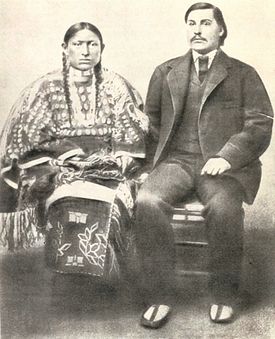George Bent | |
|---|---|
 George Bent and his first wife Magpie (Mo-he-by-vah), in 1867. | |
| Born | c. 1843 Otero County, Colorado, United States |
| Died | May 19, 1918 (aged 75) Washita, Caddo County, Oklahoma, United States |
| Buried | |
| Allegiance | Cheyenne |
| Service/ | Missouri State Guard (under the Dog Soldiers |
| Years of service | 1861–1862 CSA, 1864–1867 Cheyenne |
| Rank | Private |
| Unit | 1st Missouri Cavalry Regiment (CSA) Landis' Battery, Missouri Light Artillery (CSA) |
| Battles/wars | American Civil War |
| Spouse(s) | Magpie (Mo-he-by-vah), spring 1866; Kiowa Woman; Standing Out |
| Children | Mary, William, Daisy, Lucy, George Jr., and Charlie |
| Relations | Owl Woman (mother) William Bent (father) White Thunder (grand-father) Tail Woman (grand-mother) Silas Bent (grand-father) Charles Bent (uncle) Silas Bent III (uncle) Edmund Guerrier (brother-in-law) Silas Bent IV (cousin) Henry C. Boggs (cousin) Charles Marion Russell (cousin) |
George Bent, also named Ho—my-ike in Cheyenne (c. 1843 – May 19, 1918), was a Cheyenne-Anglo (in Cheyenne: Tsėhésevé'ho'e - ″Cheyenne-whiteman″) who became a Confederate soldier during the American Civil War and waged war against Americans as a Cheyenne warrior afterward (particularly due to the Sand Creek Massacre perpretrated by the US Army, which he survived). He was the mixed-race son of Owl Woman, daughter of White Thunder (and Tall Woman), a Cheyenne chief and keeper of the Medicine Arrows, and the American William Bent, founder of the trading post named Bent's Fort and a trading partnership with his brothers and Ceran St. Vrain. Bent was born near present-day La Junta, Colorado, and was reared among both his mother's people, his father and other European Americans at the fort, and other whites from the age of 10 while attending boarding school in St. Louis, Missouri. He identified as Cheyenne.
After the Indian Wars, Bent worked for the United States government as an interpreter. Starting in 1870 with the US Indian agent to the Cheyenne and Arapaho, he lived on the reservation in present-day Oklahoma, where he stayed to the end of his life. Although a member of the Cheyenne because he was born to his mother's clan, in the tension of the postwar years Bent felt an outsider to both Cheyenne and whites because of his dual heritage. Some Cheyenne blamed him for losses to communal land suffered by the tribe when it was forced to accept allotment of lands to individual households under the Dawes Act.
In the early twentieth century, Bent became an important source, or informant, for James Mooney and George Bird Grinnell, anthropologists studying and recording Cheyenne culture, as he was bilingual and knew the culture well. Anxious to get a book on the Cheyenne completed, Bent encouraged Grinnell to work with George E. Hyde, who probably wrote most of Grinnell's book The Fighting Cheyennes. Through Bent's letters to him, Hyde wrote his biography: Life of George Bent: Written from His Letters. It was not published until 1968.
© MMXXIII Rich X Search. We shall prevail. All rights reserved. Rich X Search
